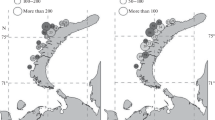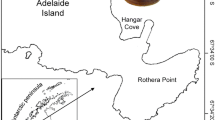Abstract
All bivalves investigated (Astarte borealis, Astarte elliptica, Macoma calcarea, Cyprina islandica, Macoma baltica, Cardium lamarcki) are dioecious. The mean egg-diameters were determined by a series of measurements for 6 bivalves and compared with data from other authors. M. calcarea does not have a direct non-pelagic larval development as previously assumed, but probably produces pelagic planktotrophic larvae. The arctic species exhibit no modification of their mode of development in the boreal area. The boreal forms spawn over a relatively short period in spring and summer. The arctic forms revealed, over long periods, ripe eggs and sperms. Apparently they begin to spawn in winter or early spring. This extension and shift of the spawning season represents adaptation of the Aretic species to the specific conditions of the Baltic Sea. The number of eggs laid by the most important bivalves were determined and correlated with the larval ecology and length of generation time.
Similar content being viewed by others
Literature cited
Baggerman, B.: Spatfall and transport of Cardium edule L. Arch. néerl. Zool. 10, 315–342 (1953).
Boyden, C. R.: A comparative study of the reproductive cycle of the cockles Cerastoderma edule and C. glaucum. J. mar. biol. Ass. U.K. 51, 605–622 (1971).
Brenning, U.: Untersuchungen über die Fauna des Eulitorals der Insel Langenwerder (Wismar-Bucht) unter besonderer Berücksichtigung der Biologie von Arenicola marina. Dissertation, Rostock 1964.
Coe, W. R.: Sexual differentation in molluses. I. Pelecypods Q. Rev. Biol. 8, 154–164 (1943).
Ekman, S.: Die biologische Geschichte der Nord-und Ostsee. In: Tierwelt der Nord- und Ostsee, pp 1–40. Ed. by G. Grimpe and D. Wagler. Leipzig: Akademische Verlagsgesellschaft 1940
Giese, A. C.: Comparative physiology. Annual reproductive cycles of marine invertebrates. A Rev. Physiol. 21, 547–576 (1959).
Gunter, G.: Chapter 8 — Temperature. In: Treatise on marine ecology and paleoecology. Vol. 1. pp 159–184. Ed. by J. W. Hedgpeth. New York: Geological Society of America 1957.
Höpner-Petersen, G.: Notes on the growth and biology of the different Cardium species in Danish brackish water areas. Meddr Danm. Fisk.-og Havunders. (N.S.) 2, 1–33 (1958)
Jaeckel, S.: Zur Ökologie der Molluskenfauna in der westlichen Ostsee. Schr. naturw. Ver. Schlesw.-Holst. 26, 18–50 (1952).
Jörgensen, C. B.: Lamellibranchia. Meddr Kommn Danm. Fisk.-og Havunders (Ser. Plankton) 4, 277–311 (1946).
Kinne, O.: The effects of temperature and salinity on marine and brackish water animals. I. Temperature. Oceanogr. mar. Biol. A. Rev. 1, 301–340 (1963).
—: The effects of temperature and salinity on marine and brackish water animals. II. Salinity and temperaturesalinity relations. Oceanogr. mar. Biol. A. Rev. 2, 281–339 (1964).
—: Physiological aspects of animal life in estuaries with special reference to salinity. Neth. J. Sea Res. 3, 222–244 (1966)
— (Ed.) Marine ecology. Vol. I. Environmental factors, Pt 1. 681 pp. London: Wiley Interscience 1970.
Lammens, J. J.: Growth and reproduction in a tidal flat population of Macoma baltica L. Neth. J. Sea Res. 3, 315–382 (1967).
Lassig, J.: The distribution of marine and brackish water lamellibranchs in the Northern Baltic area. Commentat-biol. 28, 1–41 (1965).
Lebour, M. V.: Notes on the breeding of some lamellibranchs from Plymouth and their larvae. J. mar. biol. Ass. U.K. 23, 119–145 (1938).
Loosanoff, V. L.: Reproductive cycle in Cyprina islandica. Biol. Bull. mar. biol. Lab., Woods Hole 104, 146–155 (1953).
Muus, B. J.: The fauna of danish estuaries and lagoons. Meddr Danm. Fisk.-og Havunders. (NS) 5, 1–316 (1967).
Ockelmann, W. K.: The zoology of East Greenland marine Lamellibranchiata. Meddr Grønland 122, 1–256 (1968).
Ockelmann, W. K. Developmental types in marine bivalves and their distributions along the atlantic coast of Europe. Proc. First Europ. malac. Congr. 25–35 (1965).
Oertzen, J.-A. von: Experimentell-ökologische Untersuchungen an Makrobenthosformen (Bivalvier) der Deutschen Beltsee. Dissertation, Rostock 1970.
Oertzen, J.-A. von: Abiotic potency and physiological resistance of shallow and deep water bivalves in the Baltic Sea. Oikos. (In press a).
Oertzen, J.-A. von: Bemerkungen zur Hydrographie der westlichen Ostsee unter benthos-ökologischem Gesichtspunkt. Beitr. Meereskunde. (In press b).
Oertzen, J.-A. von und G. Schlungbaum: Experimentell-ökologische Untersuchungen über O2-Mangel und H2S-Resistenz am marinen Evertebraten der westlichen Ostsee. Beitr. Meereskunde. (In press).
Oertzen, J.-A. von und S. Schulz: Beitrag zur geographischen Verbreitung und ökologischen Existenz von Bivalviern der Ostsee. Beitr. Meereskunde. (In press).
Ropes, J. W. and A. P. Stickney: Reproductive cycle of Mya arenaria in New England. Biol. Bull. mar. biol. Lab., Woods Hole 128, 315–327 (1965).
Runnström, S.: Über die Thermopathie der Fortpflanzung und Entwicklung mariner Tiere in Beziehung zu ihrer geographischen Verbreitung. Bergens Mus. Årb. (Naturv. Rekk.) 2, 1–67 (1927).
—: Weitere Studien über die Temperaturanpassung der Fortpflanzung und Entwicklung mariner Tiere. Bergens Mus. Årb. (Naturv. Rekk.) 10, 1–46 (1929).
—: Die Anpassung der Fortpflanzung und Entwicklung mariner Tiere an die Temperaturverhältnisse verschiedener Verbreitungsgebiete. Bergens Mus. Årb. (Naturv. Rekk.) 3, 1–36 (1936).
Rygg, B.: Studies on Cerastoderma edule (L.) and Cerastoderma glaucum (Poiret). Sarsia 43, 65–80 (1970).
Salleuddin, A. S.: The gonads and reproductive cycle of Astarte sulcata (Da Costa) and sexuality in A. elliptica. (Brown). Proc. malac. Soc. Lond. 36, 141–147 (1964).
Segerstråle, S.: Investigation on Baltic populations of the bivalve Macoma baltica L. Part II. Commentat-biol. 24, 1–26 (1962).
Thorson, G.: The larval development, growth and metabolism of Arctic marine bottom invertebrates. Meddr. Grønland 100, 1–155 (1936).
—: Reproduction and larval development of Danish marine bottom invertebrates. Meddr. Danm. Fisk.-og Havunders. (Ser. Plankton) 4, 1–523 (1946).
—: Reproduction and larval ecology of marine bottom invertebrates. Biol. Rev. 25, 1–45 (1950).
—: The Godthaab expedition, 1928 Scaphopoda-Lamellibranchiata. Meddr Grønland 81, 1–117 (1951).
—: Zur jetzigen Lage der marinen Bodentier-Ökologie. Verh. dt. zool. Ges. Wilhelmshaven 1951, 276–327 (1952).
Author information
Authors and Affiliations
Additional information
Communicated by O. Kinne, Hamburg
Rights and permissions
About this article
Cite this article
Von Oertzen, J.A. Cycles and rates of reproduction of six Baltic Sea bivalves of different zoogeographical origin. Mar. Biol. 14, 143–149 (1972). https://doi.org/10.1007/BF00373213
Accepted:
Issue Date:
DOI: https://doi.org/10.1007/BF00373213




